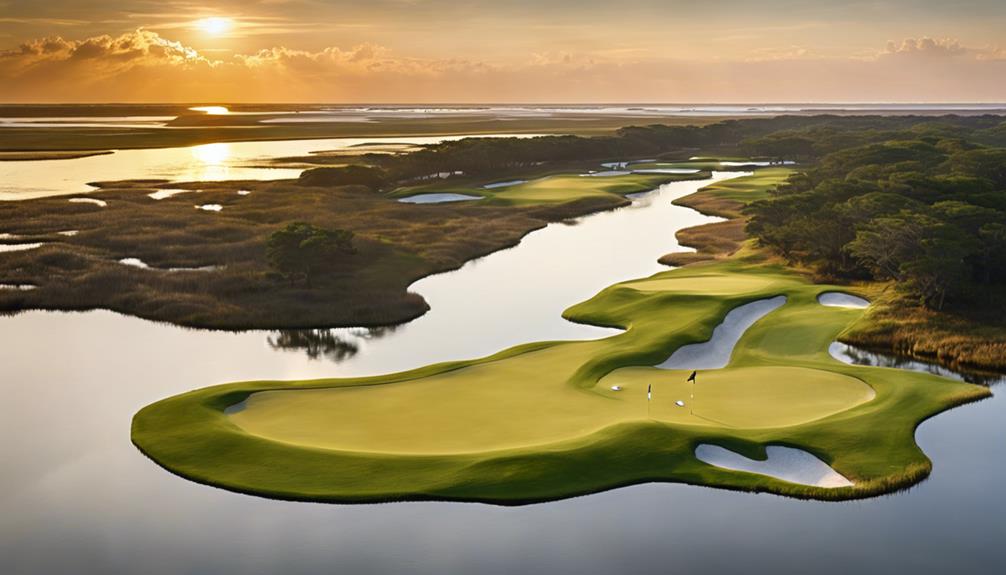Top 10 Golf Courses Championing Wildlife Preservation
Explore top golf courses leading in wildlife preservation efforts such as Augusta National Golf Club, Pebble Beach Golf Links, and Sand Valley Golf Resort. These courses excel in environmental sustainability, habitat protection, and wildlife conservation, fostering diverse ecosystems. Bandon Dunes Golf Resort showcases commitment to biodiversity conservation and native vegetation integration. Cape Kidnappers Golf Course prioritizes wildlife habitat enhancement and pest management. Kiawah Island Golf Resort focuses on water conservation and sustainable development. Arcadia Bluffs Golf Club emphasizes eco-friendly practices and reduced chemical usage. Machrihanish Dunes Golf Club excels in habitat restoration and coastal conservation. Ocean Dunes Golf Links is renowned for coastal conservation and biodiversity initiatives.
Augusta National Golf Club
Nestled within the serene landscapes of Augusta, Georgia, lies the renowned Augusta National Golf Club, recognized for its commitment to wildlife preservation. Augusta National Golf Club exemplifies environmental sustainability through its dedication to habitat protection, wildlife conservation, and ecosystem management. The club's meticulous approach to maintaining a balance between golfing excellence and environmental stewardship sets a remarkable standard for other golf courses worldwide.
In Augusta National Golf Club, environmental sustainability isn't just a buzzword but a core principle embedded in every aspect of its operations. The club's meticulous landscaping practices aim to minimize the impact on local flora and fauna, ensuring that the natural habitat remains intact. By implementing sustainable water management strategies and reducing chemical pesticide usage, Augusta National Golf Club actively promotes habitat protection and biodiversity conservation within its premises.
Moreover, wildlife conservation is a top priority at Augusta National Golf Club. The club has established protected areas within its grounds to provide safe havens for various species of birds, mammals, and insects. Through collaborative efforts with environmental experts, Augusta National Golf Club has created a harmonious environment where wildlife can thrive alongside the golfing activities. This commitment to preserving wildlife habitats showcases the club's dedication to fostering a healthy ecosystem and promoting biodiversity in the region.
Pebble Beach Golf Links
Amidst the rugged coastal beauty of California, Pebble Beach Golf Links stands as a prime example of a golf course that harmonizes with wildlife preservation efforts. Pebble Beach's commitment to sustainability initiatives is evident in the careful planning and execution of its operations to support diverse wildlife habitats.
Pebble Beach Golf Links has implemented a range of sustainability initiatives aimed at protecting and enhancing wildlife habitats within its grounds. Through strategic water management practices, Pebble Beach ensures that natural habitats are preserved and that wildlife populations are sustained. The course's maintenance practices prioritize the use of environmentally friendly products and methods to minimize its impact on the surrounding ecosystem.
One notable aspect of Pebble Beach's approach to wildlife preservation is the preservation of native plant species. By maintaining the natural vegetation indigenous to the area, Pebble Beach provides essential food and shelter for local wildlife, contributing to the overall biodiversity of the region. Additionally, the course actively monitors wildlife populations to track species diversity and abundance, allowing for informed conservation decisions.
Through its ongoing dedication to sustainability and wildlife preservation, Pebble Beach Golf Links sets a high standard for environmental stewardship in the golf industry. By prioritizing the protection of wildlife habitats and implementing ecologically responsible practices, Pebble Beach demonstrates how golf courses can coexist harmoniously with the natural environment.
Sand Valley Golf Resort
The Sand Valley Golf Resort employs sustainable practices to support wildlife conservation efforts on its premises. This commitment to sustainability not only benefits the environment but also enhances the overall golfing experience for visitors.
Here are four key initiatives that highlight the resort's dedication to preserving wildlife habitats:
- Sustainability Initiatives: Sand Valley Golf Resort has implemented a range of sustainability initiatives aimed at reducing its environmental impact. These include water conservation measures, energy-efficient practices, and waste reduction strategies that contribute to the protection of local wildlife habitats.
- Wildlife Habitat Preservation: Through careful planning and management, the resort has created and maintained wildlife habitats within its grounds. By preserving natural areas and incorporating them into the golf course design, Sand Valley provides a sanctuary for diverse species of plants and animals.
- Native Plantings: A significant aspect of the conservation efforts at Sand Valley Golf Resort involves the use of native plantings. By incorporating indigenous plant species into landscaping projects, the resort helps restore and maintain the local ecosystem, providing food and shelter for wildlife.
- Conservation Efforts: In addition to habitat preservation, the resort actively engages in conservation efforts to protect and support wildlife populations. This includes monitoring species diversity, implementing wildlife-friendly practices, and collaborating with environmental organizations to further wildlife conservation goals.
Bandon Dunes Golf Resort
Utilizing innovative land management practices, Bandon Dunes Golf Resort demonstrates a strong commitment to supporting biodiversity conservation efforts within its expansive grounds. Environmental stewardship is a key focus at Bandon Dunes, where wildlife habitat restoration plays a crucial role in preserving the natural ecosystem while allowing golfers to enjoy a unique and sustainable experience.
Through strategic planning and implementation, Bandon Dunes has successfully integrated wildlife habitat restoration initiatives into its golf course design. By incorporating native vegetation, creating wetlands, and implementing wildlife corridors, the resort provides essential habitats for a variety of species to thrive. This proactive approach not only enhances the beauty of the landscape but also contributes to the overall health of the ecosystem.
Furthermore, Bandon Dunes actively monitors and manages its environmental impact to ensure that the delicate balance between golfing infrastructure and wildlife preservation is maintained. By engaging in ongoing conservation efforts and collaborating with environmental experts, the resort continues to set a high standard for sustainable practices in the golf industry.
Cape Kidnappers Golf Course
How has Cape Kidnappers Golf Course implemented wildlife preservation efforts within its course design? Cape Kidnappers is a prime example of a golf course that prioritizes biodiversity conservation and wildlife habitat enhancement. Here are four key ways in which Cape Kidnappers Golf Course has excelled in these efforts:
- Native Vegetation Restoration: Cape Kidnappers Golf Course has undertaken extensive native vegetation restoration projects throughout its grounds. By reintroducing native plant species, the course provides vital habitats for local wildlife, including birds, insects, and small mammals.
- Wetland Creation: The course has strategically created wetlands to mimic natural water features. These wetlands serve as crucial habitats for various aquatic species, contributing to the overall biodiversity of the area.
- Wildlife Corridors: Cape Kidnappers Golf Course has established wildlife corridors that connect different parts of the course, allowing animals to move freely and access essential resources. These corridors promote genetic diversity and help prevent habitat fragmentation.
- Integrated Pest Management: To minimize the impact of pesticides on the environment, Cape Kidnappers Golf Course employs integrated pest management practices. This approach focuses on using environmentally friendly methods to control pests, reducing harm to non-target wildlife populations.
Through these initiatives, Cape Kidnappers Golf Course demonstrates a strong commitment to wildlife preservation while offering an exceptional golfing experience in harmony with nature.
Streamsong Resort
With a focus on environmental sustainability, Streamsong Resort incorporates innovative wildlife preservation strategies into its golf course design. The resort stands out for its comprehensive sustainability initiatives and eco-friendly practices aimed at minimizing its ecological footprint while providing a top-notch golfing experience.
Streamsong Resort integrates environmentally friendly practices throughout its operations. The golf courses are designed to harmonize with the natural landscape, preserving habitats for a variety of wildlife species. Through careful planning and maintenance, the resort minimizes disruption to local ecosystems, allowing flora and fauna to thrive alongside golfers.
One of the key sustainability initiatives at Streamsong Resort is water conservation. The courses utilize innovative irrigation systems that optimize water usage, reducing overall consumption and impact on local water sources. Additionally, the resort implements green waste management practices to minimize environmental pollution and promote a healthy ecosystem.
Incorporating eco-friendly practices, Streamsong Resort aims to be a leader in sustainable golf course management. By prioritizing wildlife preservation and environmental stewardship, the resort sets a positive example for the industry. Visitors can enjoy a round of golf knowing that their experience isn't only exceptional but also contributes to the preservation of natural habitats.
Kiawah Island Golf Resort

Kiawah Island Golf Resort exemplifies a commitment to environmental stewardship through its integration of sustainable practices into the design and maintenance of its golf courses. The resort's dedication to sustainable development and ecological balance sets it apart as a leader in wildlife preservation within the golfing industry.
- Native Habitat Preservation: Kiawah Island Golf Resort prioritizes the preservation of native habitats within its golf courses, ensuring that the natural ecosystem remains intact and provides a suitable environment for local wildlife species.
- Water Conservation: Through innovative irrigation techniques and water management strategies, the resort minimizes water usage on its courses, contributing to the conservation of this vital resource and promoting ecological balance.
- Organic Land Care: The resort implements organic land care practices, such as natural fertilization and pest control methods, reducing the reliance on harmful chemicals that can disrupt ecological balance and harm wildlife.
- Biodiversity Enhancement: Kiawah Island Golf Resort actively works to enhance biodiversity on its courses by introducing native plant species, creating diverse habitats that support a wide range of wildlife and contribute to the overall ecological balance of the area.
Arcadia Bluffs Golf Club
Nestled along the scenic shores of Lake Michigan, Arcadia Bluffs Golf Club demonstrates a strong commitment to environmental sustainability through its meticulous course design and maintenance practices. The club implements various eco-friendly practices to minimize its environmental impact while also actively participating in wildlife habitat restoration efforts.
Arcadia Bluffs Golf Club has integrated eco-friendly practices throughout its grounds. From using sustainable landscaping techniques to conserving water through efficient irrigation systems, the club prioritizes environmental stewardship. Additionally, Arcadia Bluffs minimizes the use of harmful chemicals and pesticides, opting for natural alternatives to maintain the course.
Wildlife habitat restoration is a key focus at Arcadia Bluffs Golf Club. The club has undertaken initiatives to restore and protect natural habitats within its property, creating safe spaces for local flora and fauna to thrive. By preserving and enhancing these habitats, Arcadia Bluffs contributes to the overall biodiversity of the region.
Through its dedication to eco-friendly practices and wildlife habitat restoration, Arcadia Bluffs Golf Club sets a high standard for environmental stewardship in the golfing industry. By balancing the needs of the course with those of the surrounding natural environment, the club showcases how golf courses can coexist harmoniously with wildlife and contribute positively to conservation efforts.
Machrihanish Dunes Golf Club

Amidst the rugged beauty of Scotland's western coast lies Machrihanish Dunes Golf Club, renowned for its commitment to environmental sustainability and wildlife preservation. This golf course stands out for its dedication to coastal conservation and biodiversity protection.
- Habitat Restoration: Machrihanish Dunes Golf Club has actively engaged in habitat restoration projects, focusing on restoring native vegetation and creating suitable habitats for local wildlife species.
- Water Management: Through innovative water management practices, the club ensures that water resources are conserved and protected. This approach not only benefits the golf course but also supports the surrounding ecosystems.
- Protected Areas: Machrihanish Dunes Golf Club has designated specific areas within its grounds as protected zones to safeguard critical habitats and nesting sites for various bird species.
- Collaborative Research: The club collaborates with local conservation organizations and research institutions to conduct studies on the diverse flora and fauna found in the region. This research informs their conservation efforts and helps maintain a delicate balance between golfing activities and wildlife preservation.
Ocean Dunes Golf Links
Located along the breathtaking coastline, Ocean Dunes Golf Links demonstrates a strong commitment to environmental conservation and wildlife protection through its innovative practices. Coastal conservation is a top priority at Ocean Dunes, with the course implementing erosion control measures such as sand dune restoration and native vegetation planting to protect the fragile coastal ecosystem. By preserving the natural landscape, the golf course minimizes its impact on the surrounding environment and promotes sustainability.
In addition to coastal conservation efforts, Ocean Dunes Golf Links is actively involved in biodiversity initiatives. The course has designated areas of native grasses and wildflowers to provide habitats for local wildlife species, including birds, insects, and small mammals. These biodiversity hotspots not only enhance the aesthetic appeal of the course but also support the overall ecosystem health by fostering a diverse array of plant and animal life.
Through its dedication to coastal conservation and biodiversity initiatives, Ocean Dunes Golf Links sets a shining example of how golf courses can coexist harmoniously with nature. By integrating environmental stewardship into its daily operations, the course ensures that future generations can continue to enjoy the beauty of the coastal landscape while preserving vital habitats for wildlife.
Frequently Asked Questions
How Do the Golf Courses Manage Invasive Species?
To manage invasive species, golf courses implement various strategies. These may include manual removal, like pulling weeds, or introducing natural predators to control populations.
By actively monitoring and promptly addressing invasive species, golf courses help maintain ecological balance and support habitat restoration.
Through these conservation efforts, wildlife rehabilitation is promoted, creating a healthier environment for native species to thrive.
Are There Any Endangered Species Protected on the Courses?
Endangered species are carefully protected on these golf courses through dedicated conservation efforts. Preservation programs focus on creating suitable habitats and implementing specific measures to safeguard the populations of these vulnerable species.
What Measures Are in Place to Reduce Water Usage?
To reduce water usage, golf courses implement various strategies. Water conservation measures include using drought-resistant grass, optimizing irrigation systems with sensors and timers, and using recycled or reclaimed water for irrigation.
Sustainable landscaping practices like xeriscaping, which involves planting native plants that require less water, are also utilized. These approaches help minimize water consumption and promote environmental sustainability within the golf course ecosystem.
Do the Courses Participate in Any Wildlife Research Programs?
Participating in wildlife research programs is crucial for effective wildlife conservation. By engaging in such initiatives, golf courses can contribute to scientific knowledge and community engagement. These programs often involve monitoring wildlife populations, studying habitat preferences, and implementing conservation strategies.
Through these efforts, golf courses can play a significant role in preserving biodiversity and promoting sustainable practices. Such involvement not only benefits the local ecosystems but also fosters a sense of responsibility and stewardship among staff and visitors.
How Do the Courses Handle Wildlife-Human Interactions?
When handling wildlife-human interactions, golf courses implement strategies to ensure wildlife conservation and habitat management. This includes creating designated wildlife corridors, installing barriers to prevent animal access to hazardous areas, and implementing educational programs for staff and visitors on coexisting with wildlife.
Conclusion
In conclusion, these top 10 golf courses are leading the way in wildlife preservation efforts, showcasing the harmonious coexistence between golf and nature.
By implementing sustainable practices and preserving natural habitats, these courses are setting a positive example for the golf industry.
Through their dedication to environmental conservation, these courses aren't only providing exceptional golf experiences but also protecting and promoting biodiversity for future generations to enjoy.
